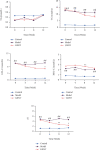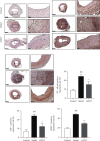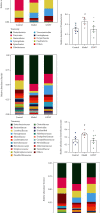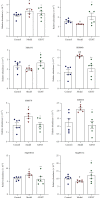Guanxinning Tablet Attenuates Coronary Atherosclerosis via Regulating the Gut Microbiota and Their Metabolites in Tibetan Minipigs Induced by a High-Fat Diet
- PMID: 35935588
- PMCID: PMC9352486
- DOI: 10.1155/2022/7128230
Guanxinning Tablet Attenuates Coronary Atherosclerosis via Regulating the Gut Microbiota and Their Metabolites in Tibetan Minipigs Induced by a High-Fat Diet
Abstract
Coronary atherosclerosis (CA) is a chronic and evolving inflammatory disease characterized by the build-up of atherosclerotic plaque in the wall of coronary arteries. Guanxinning tablet (GXNT) is a novel Chinese medicine formula, which has been clinically used to treat coronary heart disease for many years. However, the potential mechanism for treating CA remains unclear. Thus, the study was aimed at investigating the therapeutic effect of GXNT on CA and further explore the underlying mechanisms from the perspective of gut microbiota. Following the establishment of a CA model in Tibetan minipigs, GXNT was orally administrated. We simultaneously detected blood lipid levels, observed ventricular function using ultrasound examination, measured platelet aggregation, and checked changes in inflammatory factors, oxidative stress factors, and vascular endothelial injury-related indexes applying ELISA assays. Histopathological changes of coronary artery tissue were subsequently evaluated using Sudan IV staining, HE staining, Oil red "O" staining, and immunohistochemistry assays. Finally, alterations of the gut microbiota and microbial metabolites were detected using metagenomic sequencing and targeted metabolomics, respectively. The results have suggested that GXNT could regulate dyslipidemia, improve heart function, and inhibit the levels of ox-LDL, CRP, TNF-α, IL-1β, SOD, MDA, vWF, and ET-1, as well as platelet aggregation. Additionally, histopathological findings revealed that GXNT could reduce lipid deposition, alleviate AS lesions, and restrain the expressions of NF-κB, TNF-α, and MMP-9. Furthermore, the composition of the gut microbiota was altered. Specifically, GXNT could upregulate the relative abundance of Prevotellaceae and Prevotella and downregulate the abundance of Proteobacteria, Enterobacteriaceae, and Escherichia. As for microbial metabolites, GXNT could increase fecal propionic acid, butyric acid, and LCA-3S and decrease fecal TMA-related metabolites, CDCA, and serum TMAO. In sum, the results showed that GXNT had a satisfactory anti-CA effect, and the mechanism was closely associated with modulating gut microbiota and related metabolites.
Copyright © 2022 Qinqin Yang et al.
Conflict of interest statement
All authors declare that there is no conflict of interest.
Figures















Similar articles
-
Protective effects of GuanXinNing tablet (GXNT) on diabetic encephalopathy in zucker diabetic obesity (ZDF) rats.BMC Complement Med Ther. 2023 Oct 27;23(1):385. doi: 10.1186/s12906-023-04195-2. BMC Complement Med Ther. 2023. PMID: 37891536 Free PMC article.
-
Dingxin Recipe IV attenuates atherosclerosis by regulating lipid metabolism through LXR-α/SREBP1 pathway and modulating the gut microbiota in ApoE-/- mice fed with HFD.J Ethnopharmacol. 2021 Feb 10;266:113436. doi: 10.1016/j.jep.2020.113436. Epub 2020 Oct 1. J Ethnopharmacol. 2021. PMID: 33011372
-
Network Pharmacology-Based Approach Uncovers the Mechanism of GuanXinNing Tablet for Treating Thrombus by MAPKs Signal Pathway.Front Pharmacol. 2020 May 13;11:652. doi: 10.3389/fphar.2020.00652. eCollection 2020. Front Pharmacol. 2020. PMID: 32477130 Free PMC article.
-
Novel insights in the relationship of gut microbiota and coronary artery diseases.Crit Rev Food Sci Nutr. 2022;62(14):3738-3750. doi: 10.1080/10408398.2020.1868397. Epub 2021 Jan 5. Crit Rev Food Sci Nutr. 2022. PMID: 33399007 Review.
-
Role of Gut Microbiota and Their Metabolites on Atherosclerosis, Hypertension and Human Blood Platelet Function: A Review.Nutrients. 2021 Jan 3;13(1):144. doi: 10.3390/nu13010144. Nutrients. 2021. PMID: 33401598 Free PMC article. Review.
Cited by
-
Guanxinning Tablet Alleviates Post-Ischemic Stroke Injury Via Regulating Complement and Coagulation Cascades Pathway and Inflammatory Network Mobilization.Drug Des Devel Ther. 2024 Sep 18;18:4183-4202. doi: 10.2147/DDDT.S479881. eCollection 2024. Drug Des Devel Ther. 2024. PMID: 39308695 Free PMC article.
-
Intestinal flora: A new target for traditional Chinese medicine to improve lipid metabolism disorders.Front Pharmacol. 2023 Mar 1;14:1134430. doi: 10.3389/fphar.2023.1134430. eCollection 2023. Front Pharmacol. 2023. PMID: 36937840 Free PMC article. Review.
-
Viral metagenomics combined with non-targeted serum metabolomics reveals the role of enteroviruses in a mouse model of coronary heart disease.Virol J. 2024 Jul 30;21(1):169. doi: 10.1186/s12985-024-02412-z. Virol J. 2024. PMID: 39080726 Free PMC article.
-
Characteristics of Metabolites in the Development of Atherosclerosis in Tibetan Minipigs Determined Using Untargeted Metabolomics.Nutrients. 2023 Oct 18;15(20):4425. doi: 10.3390/nu15204425. Nutrients. 2023. PMID: 37892500 Free PMC article.
-
Protective effects of GuanXinNing tablet (GXNT) on diabetic encephalopathy in zucker diabetic obesity (ZDF) rats.BMC Complement Med Ther. 2023 Oct 27;23(1):385. doi: 10.1186/s12906-023-04195-2. BMC Complement Med Ther. 2023. PMID: 37891536 Free PMC article.
References
MeSH terms
Substances
LinkOut - more resources
Full Text Sources
Medical
Research Materials
Miscellaneous

